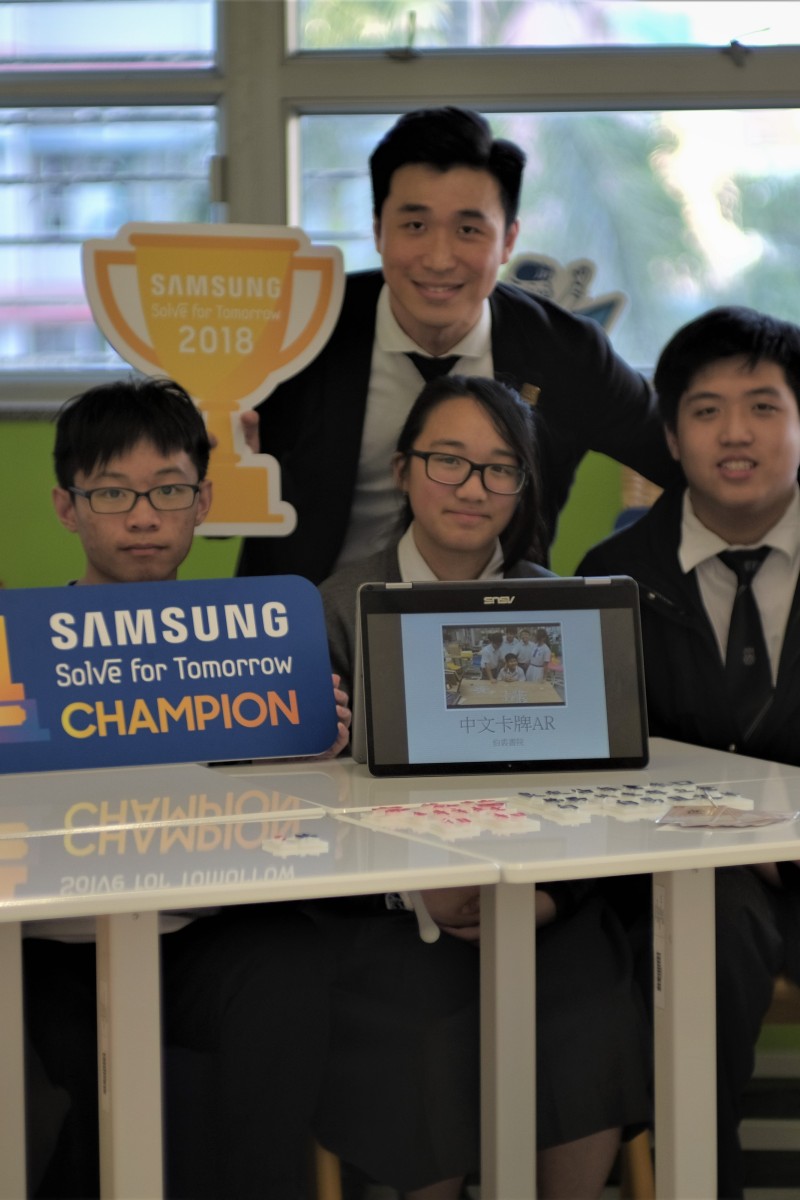
We talk to one of the winning teams at the Solve for Tomorrow competition to find out how they came up with their great idea that could help their peers with Special Education Needs
 (From left) Isaac Ting Yat-kit, Marco Leung Chun-hei, their mentor Jack Chan Chi-ho, Effie Tse Ching-lam, Cobe Lam Tsz-yeung, and Wong Man-kin
(From left) Isaac Ting Yat-kit, Marco Leung Chun-hei, their mentor Jack Chan Chi-ho, Effie Tse Ching-lam, Cobe Lam Tsz-yeung, and Wong Man-kinThere are many issues in the world that need solving, and you may want to help but not know where to begin. Five students from Pak Kau College decided to start with solving the problems their fellow classmates struggle with at school.
Last year, the group of friends noticed that one of them, 17-year-old Wong Man-kin, was having trouble remembering characters in Chinese class, they all wanted to think of way to help him.
That same year in July, South Korean electronics company Samsung held a competition called Solve for Tomorrow, which challenged teams to build a Stream device that would help Special Education Needs (SEN) students’ learning.
Technology like augmented reality is changing the way we study in class
Seeing that their goals were almost the same, the students decided to join the competition, where they created a tool to help SEN students with their Chinese learning.
Man-Kin, 17, who is a SEN student, was especially passionate about helping students like him and was eager to join the competition, which they won.
“I want to help people who are just like me. I’m lucky because I have good, supportive friends, but some students have to tackle learning difficulties on their own” Man-kin tells Young Post.
“I used to be scared to ask for help,” he says.
“When I didn’t know how to write a certain word, I would think: if I ask other people, will they laugh at me, or will I be bothering them? So normally I’d bury my questions … I don’t want SEN students to feel helpless like I did.”
They created a tool which they named Chinese Tiles AR. The students used 3D printing to create tiles that show the different parts that make up Chinese characters. They also built a phone app.
Learners can put together Chinese characters with the tiles, and then use the app to scan the characters with their phone.
This is where the AR, or augmented reality, part of Chinese Tiles AR comes into play. Upon scanning the tiles, an explanation and the pronunciation of the word appears on the screen.
“Altogether, there are about 100 words in our database. Although the competition is now finished, we are still trying to add more to it,” says Isaac Ting Yat-kit, 16.
The device also allows them to mix and match different tiles and discover patterns in the language.
Ethnic minority students in HK lack support and Cantonese assistance at local schools
As much as they were thrilled to win the competition, the students all agree that the most important thing they gained is a better understanding of SEN students.
In Hong Kong, there are 45,360 SEN students in public primary and secondary schools, making up seven per cent of the student population, according to the Education Bureau.
Effie Tse Ching-lam, 17, said that before the competition, just like most people, she too thought reading more books could help SEN students get better. “But we never really looked into their problems and tried to think from their perspective or realised what they really need,” says Effie.
Because of that, before designing their device, the team interviewed SEN students to better understand the everyday challenges they face.
“They look at Chinese characters as if they’re looking at pictures, because they don’t see the relationship between different components,” says Effie.
“That’s why they find it hard to memorise. Often, they miss certain parts [of the character] as well.”
The team hope that as technology evolves, more people will be able to access creative tools to help them with their education.
They have always been eager to help underprivileged people in Hong Kong. Last year, they took part in the Education Bureau-organised Smart City Project Programme, in which they designed a smart city that took the concerns of people with disabilities into consideration.
“Even though [underprivileged people] have very different lives to ours, I don’t think it should be the case. I believe everyone deserves to enjoy life.” says Marco Leung Chun-hei, 16.
“And now, as we have more knowledge of technology, we should use it to help other people.”
Cobe Lam Tsz-yeung, 17, agrees. “They don’t want this problem, but they can’t help it. I feel sad and empathetic for them … and if I turned away from them, it would make me inhuman.”
